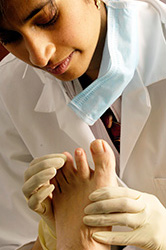 There are three mains way in which diabetes can lead to foot problems – it can affect the circulation, impair sensation in the foot and change the foot shape. A loss of feeling can be particularly dangerous as you might not even realise that you have injured yourself unless you actively check that your feet are ok.
There are three mains way in which diabetes can lead to foot problems – it can affect the circulation, impair sensation in the foot and change the foot shape. A loss of feeling can be particularly dangerous as you might not even realise that you have injured yourself unless you actively check that your feet are ok.
Regular foot health checks with a podiatrist are important in order to monitor these issues, to identify and/or treat any developing problems and prevent future complications.
During a diabetic foot health check at our clinic, the podiatrist will check the blood supply by feeling for pulses in the foot. We will also assess the quality of the pulses using a Doppler ultrasound machine. We check the nerve sensation status of the feet by carrying out a light touch test using a monofilament and performing a vibration perception test. These tests will identify any problems in your feet and we can also arrange for a written report to be sent to your doctor to keep them in the loop about your foot health status.
How To Prevent Foot Problems:
1. General measures
Maintain good control of your blood sugar level. It is also very important not to smoke.
2. Daily foot checks
It is important to check your feet as part of your daily routine as you may not otherwise realise you have injured your foot. Look out for any signs of infection including redness (in a small area or spreading), pain, pus/liquid, swelling, or a loss of feeling/sensation/function in the area. Please ask a friend or relative to help you if you cannot reach or see your feet yourself.
3. General nail cutting
It is advised that diabetics should not cut their own nails because of the risk of an infection.
4. Treating hard skin
A foot file can be used to reduce hard skin and then gently rub cream over the thickened skin. For corns and very hard skin, it is best to see a podiatrist to treat the areas. Do NOT use a blade, razor or scalpel yourself.
5. Bathing
Wash your feet with warm water and soap. It is important to check the temperature of the bath water before you get in as you may lose temperature sensation in your feet and not realise it. After washing, make sure you dry carefully in between your toes – this will prevent the skin cracking.
6. Socks and hosiery
Natural fibres such as cotton or wool are preferable. Change socks every day.
7. Footwear
Always ensure that your shoes have a round wide, deep toe box and compare the shape of your toes with that of the shoe. Laces are best for fastening shoes, but buckles or Velcro straps are just as effective. A ¼ inch of space between the end of your longest toe and the end of the shoe is ideal. If your feet swell, take care not to lace, buckle or fastening too tightly.
8. Heat
Your feet may not be able to tell hot from cold. Don´t use hot water bottles or warm your feet in front of a fire.
Do not do the following things:
- Do not ignore any problems your feet. If there is distinct colour change, any swelling, pain, heat or other abnormality seek professional help immediately.
- Do not use razor blades or sharp implements to remove hard skin as this could lead to an infection.
- Do not use corn plasters as these may contain acid which is harmful to your skin.
- Do not wear badly fitting shoes or walk barefoot.
- Do not wash your feet in strong disinfectants.
In the event of an emergency
If a minor injury occurs on your foot, cleanse with warm salt water, dry the foot carefully with a soft clean towel without touching the actual wound and cover with dry dressing.
If for any reason, there are problems in contacting us, please telephone your GP immediately.
